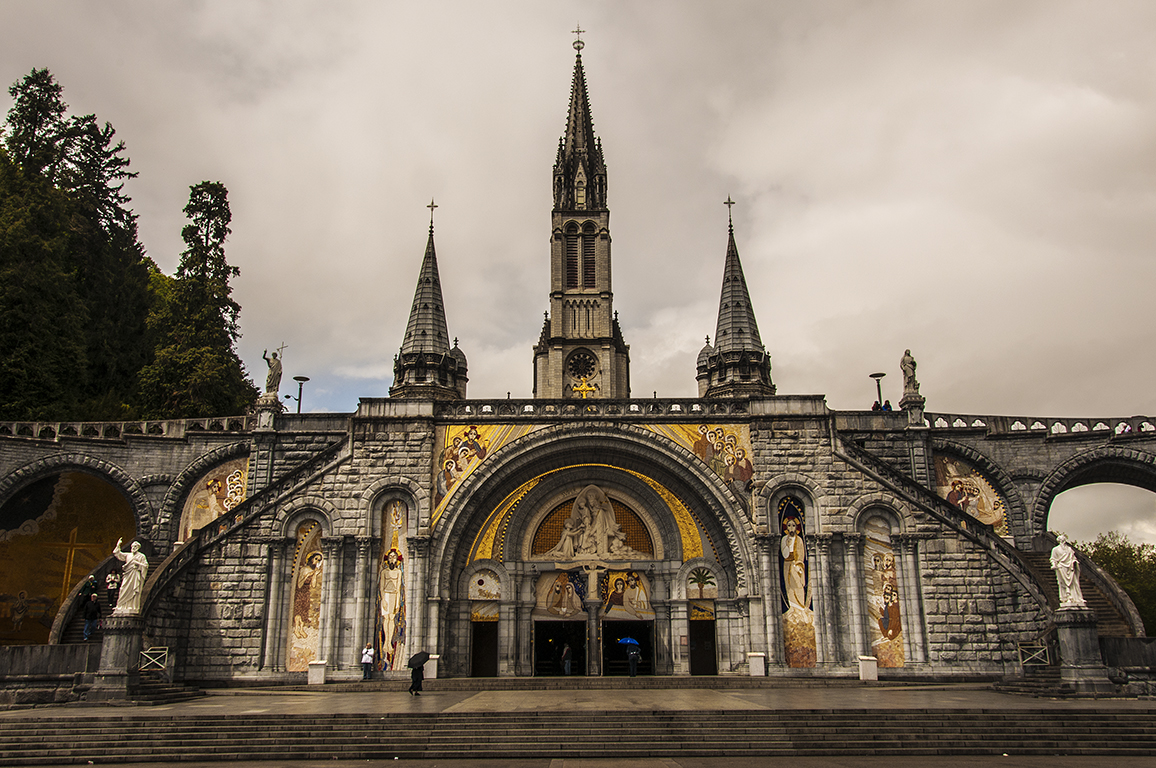The bishop responsible for the Shrine of Lourdes has received a “pile of letters” from Catholics across the world as he considers whether to remove mosaics by the alleged abuser Fr Marko Rupnik.
Bishop Jean-Marc Micas of Tarbes and Lourdes told CNA that he hopes to decide the mosaics’ future by the spring. He formed a special commission last year to determine the best course of action.
“This occupies my mind, my prayer, and my heart every day, especially when I meet victims of abuse,” Micas said.
Speaking at the bishop’s residence in Lourdes, Micas acknowledged that, for him, this is a “very, very difficult decision to make”, adding: “But I have to make it.”
Since forming the commission, Micas has met with victims of abuse, heard from sacred art specialists, and consulted with experts from across France who make up the commission.
“And we’ve received letters, letters, a pile of letters – people very angry because the mosaics are still there and other people who were very angry at the idea we could remove them,” he said.
The bishop shared how he was inspired to form the commission after speaking to a woman from England who had served as a volunteer in Lourdes for many years, aiding the sick who come to wash in the baths seeking healing.
“She told me…‘I met many, many women who come to Lourdes in order to ask for special healing after abuse. And they come to the Immaculate Conception to be cured, to be healed, to find consolation.’”
The woman went on to describe how the architecture of Lourdes’ Basilica of the Immaculate Conception with its grand entrance of two large curving ramps on either side of “Rosary Square” was meant to convey “the arms of the Immaculate Conception embracing her children”.
“And now, for me, for them, the arms are not the arms of the Immaculate Conception,” she told him. “They are the arms of Father Rupnik.”
This encounter left an impression on the bishop and the rector of the Lourdes sanctuary, and Micas shortly after formed the commission on Rupnik’s mosaics in March 2023.
Approaching the Sanctuary of Our Lady of Lourdes, it is hard to miss the 21st-century addition by Rupnik’s mosaic school, Centro Aletti, to the facade of the lower basilica. Rupnik’s wide-eyed figures are set against bright gold backdrops in a marked contrast with the shrine’s neo-Gothic stone façade.
The original basilica was built according to the request of the thirteenth apparition to Bernadette Soubirous in the Lourdes Grotto in 1858: “Go and tell the priests to build a chapel here and that people should come in procession.”
The Rupnik mosaics, added in 2008, depict the luminous mysteries of the rosary with the Wedding Feast at Cana in the centre. Rupnik’s signature red dot decorates one of the arched panels above the entrance.
Rupnik, a priest and artist, has been accused of spiritual, psychological, and sexual abuse of religious sisters. He was removed from the Jesuits last June, and the Vatican has announced that he will face a canonical process over the abuse allegations after Pope Francis decided to waive the statute of limitations on the claims.
The priest’s prolific artistic career in the years following his alleged abuses has created a problem for many shrines and Catholic churches across Europe and North America. Rupnik’s workshop has accounted for projects for more than 200 liturgical spaces around the world, including Fatima, the Vatican, the John Paul II shrine in Washington, DC, and the tomb of St Padre Pio.
Some have argued that to remove Rupnik’s art would be a manifestation of “cancel culture” and point to the work of Renaissance artists with scandalous personal lives.
Others have pointed to the allegations that his spiritual abuse of religious sisters included persuading them that sinful acts would worship God, suggesting that his sacred art might communicate “a false Gospel”.
For Lourdes, the problem is acute because the Marian shrine is known as a place of healing and consolation, and should be a privileged place for abuse victims seeking healing. The French bishops have emphasised this by gathering in Lourdes to pray and fast for victims of abuse.
Bishop Micas is aware that many other Catholic shrines and churches that also contain Rupnik’s mosaics may be looking to Lourdes to see what he decides.
“I very often say that the decision we will make here is made for Lourdes and only for Lourdes,” he said.
“It cannot be extended to any other place where there are mosaics of Rupnik’s because Lourdes is Lourdes and it is for weak people, sick people, special people. And we have to serve the message of Lourdes, whatever the cost.”



 Loading ...
Loading ...